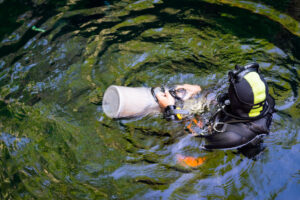What is Task Loading?
Task loading in scuba diving refers to the cumulative effect of multiple responsibilities or tasks that a diver must manage simultaneously. The concept is rooted in human factors psychology and is crucial to understanding and enhancing diver safety. When task loading becomes excessive, the risk of errors or omissions increases, potentially compromising critical safety procedures that would typically be routine for the diver.
Understanding Task Loading
Task loading may arise from several sources. Primary factors include environmental conditions (such as current, visibility, and depth), equipment management, navigation, communication, physiological demands (like buoyancy control and breathing), and psychological pressures. Each task requires a portion of the diver’s attention and cognitive capacity, and as more tasks are added, the diver’s ability to effectively manage all tasks may become strained.
For example, a diver navigating a complex underwater cave while managing multiple pieces of equipment, handling a strong current, and monitoring air supply is under significant task loading. If an unforeseen event occurs, such as equipment failure or a sudden change in environmental conditions, the diver may struggle to respond appropriately, leading to an increased risk of an accident.
Effects of Task Loading
When task loading is manageable, it can foster skill development and enhance the diver’s capability to handle complex situations. However, when it becomes excessive, it can overwhelm the diver’s cognitive capacity, leading to detrimental effects such as tunnel vision, increased stress, and reduced decision-making ability. In extreme cases, it can result in panic, which is a leading cause of fatalities in scuba diving.
Moreover, high task loading can impact the diver’s situational awareness – their perception of environmental elements, comprehension of their meaning, and projection of their status in the near future. Reduced situational awareness may lead to critical oversights, such as neglecting to monitor air supply or missing important communication signals from a buddy diver.
Managing Task Loading
Effective management of task loading is a cornerstone of safe diving practices. It involves appropriate training, planning, equipment selection, and situational awareness. Divers are encouraged to only accept tasks within their skill level and to progressively increase task complexity as their experience grows.
Training should encompass not just technical skills, but also cognitive strategies for managing multiple tasks and stress, as well as emergency procedures. Pre-dive planning should consider potential task loading and include contingencies for unexpected events.
Equipment selection and preparation also play a role in managing task loading. Divers should familiarize themselves thoroughly with their equipment and opt for simplicity and reliability where possible to reduce potential sources of task loading. For example, a diver could choose a dive computer over separate depth gauge and timer to consolidate tasks.
Mitigating Risk
Lastly, divers should adopt strategies to mitigate the risk associated with task loading. These include practicing emergency scenarios, regularly checking equipment, maintaining physical fitness, and adopting a conservative approach to diving.
Communication with dive buddies and dive leaders about potential task loading and a diver’s comfort level with it can also help manage risk. It’s essential that divers feel comfortable expressing concerns and backing out of a dive if they feel task loading is excessive.
In conclusion, task loading is a critical concept in scuba diving that requires careful consideration and management. Understanding its sources, effects, and strategies for managing it can significantly enhance diver safety and performance. As scuba diving continues to evolve, so too will our understanding of task loading and how best to navigate it.
Task Loading and Human Performance
Understanding human performance and its limitations is central to grasping the concept of task loading. Humans, as cognitive beings, have finite mental resources that are allocated to various tasks. When the demands of these tasks exceed the available resources, the quality of performance declines. This is the essence of task loading.
In scuba diving, the diver must constantly monitor multiple variables, such as buoyancy, depth, time, air supply, and navigation, while also maintaining spatial orientation and temperature regulation. Add to this the physiological stressors such as cold, pressure changes, and potential narcotic effects of breathing gases at depth, and it becomes clear that scuba diving is a highly demanding activity even under optimal conditions.
Task Loading and Decision-Making
Task loading can significantly impact decision-making processes. As more tasks are added, cognitive resources are stretched thin, leaving less mental capacity for problem-solving and decision-making. This can lead to poor choices under pressure, potentially escalating a manageable situation into a critical one.
For example, a diver who is heavily task-loaded may overlook a slowly leaking regulator or not notice the early signs of hypothermia. A sudden equipment failure or onset of decompression sickness might not be managed correctly, leading to a dangerous situation that could have been avoided with less task loading.
Diver Training and Task Loading
Diver training programs often address task loading, teaching divers to manage multiple tasks efficiently and safely. For instance, divers are trained to automate certain tasks, such as buoyancy control and basic navigation, so they can allocate more cognitive resources to unexpected or complex tasks.
Simulation training is another effective method to prepare divers for high task loading scenarios. By practicing in a controlled, simulated environment, divers can learn to manage stress and make sound decisions under high task loading conditions.
Technological Aids in Managing Task Loading
The use of technology can also help manage task loading. Modern diving computers can monitor depth, time, temperature, and even calculate decompression stops, relieving the diver from these tasks. However, reliance on such aids should not replace fundamental diving skills and understanding, as technology can fail.
Task loading is an integral part of scuba diving that demands thorough understanding and diligent management. With appropriate training, planning, equipment, and mindset, divers can manage task loading effectively, ensuring safe and enjoyable dives. The key lies in recognizing personal limits, staying within one’s comfort zone, and progressively building skills and experience. The ocean offers a world of wonder, and understanding task loading is a step towards exploring it safely.

















